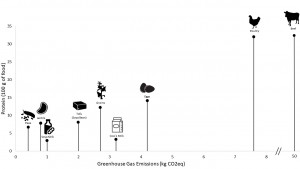
The Institute of Food Science and Technology (IFST) held their inaugural Science Communication Competition in July 2019, which provided undergraduate and postgraudate students based in the UK the opporutnity to about the theme of this year’s IFST Spring Conference to develop their skills for science communication. Food and Health Intern at European Food Information Council (EUFIC), a partner of PROTEIN2FOOD, Cathrine Baungaard has won the competition with her essay. Read the essay below or in the Journal of the IFST.

Quin-what?
Cultivating Exotic Protein-rich Crops in Europe
Quinoa (kinwa)! Chances are you have heard of it, maybe even enjoyed it in a salad or stew.
Thanks to innovative research and technology, exotic crops like quinoa and amaranth are making their debut out in the European fields and could be finding their way on to our dinner plates within exciting new food products.
A case of unsustainable protein demand
There is no doubt, British people love their protein. A cooked breakfast just isn’t the same without the rashers of bacon and we wouldn’t want to forget about the childhood favourite – bangers and mash. For centuries animal protein has been considered the centrepiece of the Western meal. Yet, it is no secret, our growing demand for protein is causing unprecedented damage to the natural environment. For example, our food systems are a major contributor to climate change, accounting for 30% of total global greenhouse gas emissions, of which meat and meat-derived products account for the majority(1)! Additionally, animal derived products take up more than 50% of Europe’s total water consumption, talk about being thirsty!(2). But that isn’t the end of the story. Our overreliance on monocultures, producing a single crop at a time, in wheat, corn and even bananas are placing our supply chains at greater risk from diseases and future climatic change, a seriously dangerous situation. In addition, as the world population continues to grow, so too will the demand for protein. Therefore, addressing how we can meet these protein needs in a healthy and sustainable way, may be the biggest challenge society and the food industry face.
To meat or not to meat?
That is the question and with initiatives like ‘Veganuary’ becoming more mainstream, consumers are increasingly answering, no thank you. Consumers are becoming more conscious of ‘sustainable eating’, opting for more flexitarian consumption patterns and demanding more plant-based products. A prime example was the overwhelming success of Gregg’s vegan sausage roll. This rapidly growing market of plant-based products represents a major opportunity to provide more and attractive plant-based options for consumers, while meeting nutritional needs and helping with the transition to more sustainable production. But how do we merge, food security, biodiversity, environmental and human health together to solve the challenges we currently face?
Well, before we dig deeper, we must first understand the differences between plant- and animal-based proteins from a health perspective. The protein in our food is comprised of 20 amino acids, the building blocks of protein. Nine of these amino acids are ‘essential’, which means our bodies are incapable of creating them, they come exclusively from our diets. However, plant-based proteins lack at least one or more of these nine ‘essential’ amino acids compared to animal-based proteins, rendering them ‘incomplete’.
But don’t worry! Combinations of plant-based protein sources in foods and throughout the day are enough to deliver the ‘essential’ amino acids we need. Interestingly, certain crops and seeds are termed ‘high-quality’ proteins, because they are almost equivalent to animal proteins. For example, quinoa and amaranth are considered high-quality because they contain the ‘essential’ amino acid lysine(3), while grain legumes (lentils, chickpeas) have a ‘high-quantity’ of protein (about 20%)(4). These crops and legumes are perfect examples of protein sources that can help increase the transition towards more plant-based proteins, leaving a positive impact on our health and environment.

Figure 1. Protein content and Greenhouse Gas Emissions for various protein-rich foods(5),(6)
#PROTEIN2FOOD
To address the global protein challenge, PROTEIN2FOOD is developing high-quality and quantity plant-based protein products through improved and sustainable processing and production methods. Spanning the entire food value chain, the 19 international project partners are using a variety of scientific and technological approaches to further our understanding and development of innovative solutions and products. The project has four overall aims of:
1 enhancing protein production with effective breeding techniques;
2 increasing Europe’s arable land for protein production;
3 increasing agricultural biodiversity with novel crops and
4 developing protein-rich food products that are so attractive consumers will choose them over animal-based proteins.
Here, we focus on two examples of scientific and technological research in crop production and food processing that have originated from the project, which could help the food industry solve the challenges of protein needs and their environmental implications.
Crop production
Currently, the main source of plant-based protein across the EU is soy; imported from countries like Brazil, it helps to exacerbate environmental issues such as deforestation(7). Therefore, identifying crops for Europe that are suitable for sustainable production methods, climate change mitigation and take nutrition into consideration are becoming increasingly important.
By determining and improving genetic traits that are needed for optimum protein production, such techniques could help identify the most beneficial crops to produce in Europe. Through studying the Ribonucleic Acid (RNA) – a molecule that transports genetic information to create specific proteins – transcripts of seeds and legumes, PROTEIN2FOOD has been able to determine the molecular markers for protein production. Currently, PROTEIN2FOOD has transcriptome data on three quinoa genotypes, which can further be used to develop genetic markers for protein content, particularly valuable for plant breeding(8). This novel use of technology has also resulted in the discovery of two quinoa varieties that have much higher protein content compared to other varieties, helping to increase total protein production(8). As such, quinoa’s unique characteristics makes the seed an ideal alternative to ensuring the production of high-quality and quantity protein in preparation for our changing consumer demand and climate.
Additionally, researchers are using advanced X-ray technology (micro-tomography) to create 3D images of the internal structure of the same seeds and legumes to screen for qualitative traits. Through this, researchers can examine the varying densities and textures within the seeds, as they absorb X-rays differently. Although, whilst micro-tomography is well-established in fields like biology, it is relatively novel in the agriculture-food sector. However, PROTEIN2FOOD researchers have developed X-ray scanning protocols that will help bridge the gap between genetic information (genotype) and the physical characteristics (phenotype) of these protein-rich crops, assisting researchers in determining which seeds and crops have the highest protein content, helping to increase total protein production(9).
Identifying the most productive crop varieties, will not only help the industry take advantage of the most genetically favourable properties to maximise protein yield on limited land, it will also allow us to move towards more sustainable and well managed crop production. The scientific and technological research from this project can for example, help plant-breeders target their breeding programmes to create new cultivars with improved nutritional traits, while giving Europe the opportunity to increase its diversity of protein rich crops and legumes for both production and consumption.
Identifying the most productive crop varieties will not only help the industry take advantage of the most genetically favourable properties to maximise protein yield on limited land, it will also allow us to move towards more sustainable and well managed crop production.
Got milk? Well… plant-based milk?
With the larger-than-life Oatly Campaigns plastered across the UK, it doesn’t come as a surprise that the plant-based milk market has been experiencing unprecedent growth. This trend is largely driven by consumers’ concerns for health, environmental and animal welfare issues. Currently, soya milk is the only nutritionally balanced competitor to conventional cow’s milk, packing an attractive 8.7 grams of protein(5). Yet, this option is not the most sustainable choice, as soya has long supply chains and is unable to grow in cold climates(7) (Figure 1). On top of this, many plant-based foods have lower sensory qualities compared to animal-based foods, therefore novel plant-based products with high consumer acceptance are necessary to support the transition to more plant-based diets. This is where lentils and PROTEIN2FOOD come into the picture. Lentils are both high in protein (31%) and contain the ‘essential’ amino acids, leucine and lysine (4), as opposed to almond milk (5). Using lentils, PROTEIN2FOOD has developed a novel lentil milk with a protein content similar to cow’s milk; comparing well based on textural, organoleptic (involving the senses) and nutritional properties to other plant-based milks(4). These advances demonstrate the great potential legumes (lentils) can have in providing nutrition to the diet through valuable environmentally friendly plant-based proteins.
Through the collaboration with small-to-medium sized enterprises, PROTEIN2FOOD has ensured that the ingredient composition, recipes and processes can be effectively transferred to relevant industrial product lines and environments, helping to increase market opportunities and for the industry to further develop new varieties of plant-based protein products.
Sharing is caring: from research to industry
There can be no doubt that plant-proteins are here to stay and have the power to revolutionise the food system. However, research not communicated is research not implemented. Therefore, the advances in scientific and technological research created by projects such as PROTEIN2FOOD must be shared with the food industry to lessen our food systems’ impacts on the planet, while increasing our protein production and helping us to lead healthier and more sustainable lives. PROTEIN2FOOD is an excellent example of a multi-disciplinary research project that could benefit the industry in providing novel consumer accepted plant-based products and more sustainable processing techniques. In doing so, this will not only benefit the consumers, but also the planet further down the line. PROTEIN2FOOD is not only taking plant-based protein mainstream, it hopes to make plant-based proteins great again!
References:
1.Vermeulen SJ, Campbell BM, Ingram JSI. Climate Change and Food Systems. Annual Review of Environment and Resources. 2012; 37: 195-222.
2. Vanham D, Bidoglio D. A review on the indicator water footprint for the EU28. Ecological Indicators. 2013;26: 61-75.
3. Scanlin L, Lewis KA. Chapter 14 – Quinoa as a Sustainable Protein Source: Production, Nutrition and Processing. In Nadathur S.R, Wanasundara J.P.D, Scanlin L. (eds.) Sustainable Protein Sources. USA: Academic Press; 2016. p.226.
4. Jeske S, Bez J, Arendt EK, Zannini E. Formation, stability and sensory characteristics of a lentil-based milk substitute as affected by homogenization and pasteurization. European Food Research and Technology [online]. 2019 [cited 2019 May 22]. In Press. Available from: https://cora.ucc.ie/handle/10468/7869.
5. McCance, RA, Widdowson, EM. The Composition of Foods: from: https://www.gov.uk/government/publications/composition-of-foods-integrated-dataset-cofid.
6. Poore J, Nemecek T. Supplementary Materials for Reducing food’s environmental impacts through producers and consumers. Science. 2018; 30:987.
7. Thrane M, Paulsen P.V, Orcutt M.W, Krieger T.M. Chapter 2 – Soy Protein: Impacts, Production, and Applications. In
8. Swedish University of Agricultural Sciences. Deliverable 1.4 Protein quality and quantity transcriptomes available for target crops for further use in developing SNPs. [Online].
